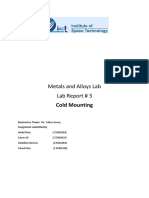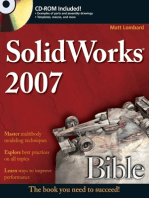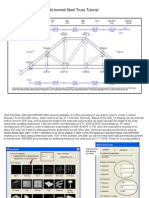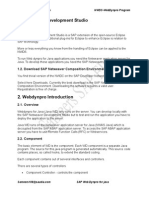Cold Formed Steel Sections-Libre
Cold Formed Steel Sections-Libre
Uploaded by
Cernomodiac NicolaeCopyright:
Available Formats
Cold Formed Steel Sections-Libre
Cold Formed Steel Sections-Libre
Uploaded by
Cernomodiac NicolaeOriginal Description:
Original Title
Copyright
Available Formats
Share this document
Did you find this document useful?
Is this content inappropriate?
Copyright:
Available Formats
Cold Formed Steel Sections-Libre
Cold Formed Steel Sections-Libre
Uploaded by
Cernomodiac NicolaeCopyright:
Available Formats
IJASCSE, Vol 2, Issue 1, 2013
Feb. 28
Theoretical study of axially compressed Cold
Formed Steel Sections
Sreedhar Kalavagunta , Sivakumar Naganathan, and Kamal Nasharuddin Bin Mustapha
Universiti Tenaga Nasional,
Jalan IKRAM-UNITEN, 43000,
Department of Civil Engineering,
Kajang, Selangor, Malaysia.
Abstract Conceptual and finite element
analysis oriented design of cold formed steel
columns are presented in this paper. Total four 1
meter channel lipped section with thickness of 1,
1.2, 1.5 and 1.9 are tested. All columns were
tested under a pure axial load, Conceptual design
results are compared with finite element analysis
for axially loaded compression members. The
results provide useful information regarding
allowable load estimation of cold formed steel
column section. Based on the results, design
recommendations were proposed. The proposed
design approach is recommended for the design
of complex shape of cold formed steel section,
where design rules are not available in
standards.
Keywords-Cold formed steel, Axial Stress, Design
Strength, Effective Width Method, Direct Strength
method.
I.
INTRODU CTION
production, fast and easy erection, installation etc.
In the recent decades, the use of Cold formed steel has
increased widely in the construction industry because of its
unique characteristics and advantages. The behaviors of CFS
structures are influenced by effects such as Local Buckling,
Distortional Buckling and Global Buckling [1, 2] which arises
due to the Slenderness of members. This makes the design and
analysis often more complex. The recent research and
investigation on cold formed steel shows advancements in
design specification and manufacturing processes for most of
the standard sections [3,4,5,6,7].
The Effective Width Method and Direct Strength Method
(DSM) are the only two basic designs that are accessible now
by the design codes including North American Specification
for Cold-Formed Steel Structural members (AISI-2007) [8].
Effective Width method can take into account the interaction
Cold Formed Steel (CFS) members are widely used in
between Local and Lateral buckling. However, as structural
building constructions, bridge constructions, storage racks,
shapes became more complex with additional lips and
highway
bins,
intermediate stiffeners, the accurate computation of the
transmission towers, car bodies, railway coaches and various
effective widths of individual elements of the complex shapes
types of equipment. These sections are cold formed from
becomes more difficult and inaccurate. In order to overwhelm
carbon or low alloy steel sheet, strip, plate, or flat bar in cold-
this problem, the Direct Strength method (DSM) was
rolling machines or by press brake or by bending brake
developed. However, finite element analysis like ANSYS,
operations. The thicknesses of cold formed steel members do
ABAQUS etc. are the best options for the design of CFS with
usually range from 0.378 mm to 6.35 mm. CFS sections
any cross sectional shapes, but most of the structural consulting
gained special attention in research due to its major
firms are using basic FEA software's like STAAD.Pro,
advantages like flexibility in drawing to any shape, high
SAP2000, RAM Structural System, STRAP etc., This paper
strength and stiffness, ease of prefabrication and mass
presents a comparative study of cold formed steel column
products,
www.ijascse.in
drainage
facilities,
grain
Page 67
IJASCSE, Vol 2, Issue 1, 2013
Feb. 28
section design using STAAD.Pro, FEA results with
Since the thickness of individual plate elements of CFS
conceptual design as per AISI.
structural members are normally small compared to their
width, buckling and post buckling strength are two major
II. MATERIALS AND METHODS
concerns for strength prediction of CFS structural members.
Cold formed steel sections are usually thinner and have a
Unlike hot rolled members, CFS members normally buckle
mode of failure and deformation, which are not commonly
prior to section yielding. Further, CFS compression elements
encountered in normal structural steel design. A thin
do not collapse when the buckling stress is reached.
walled member under compression loads most likely
Additional load can be carried out by the element after
undergoes various buckling modes like local buckling,
buckling called as post buckling strength, by means of stress
Distortional
redistribution [12].
buckling,
Flexural
buckling,
Torsional
buckling, Flexural-Torsional buckling. For a typical CShape column under pure axial compression, the Local
In this Effective Width approach [8], instead of considering
Buckling mode is the dominant mode. However, a small
the non-uniform distribution of stress across the width of the
change from this prototype, e.g., the addition of lip
element, it is assumed that the total load is carried by a
stiffeners and web stiffeners, can markedly increase the
fictitious width b, which is subjected to a uniformly
local buckling stress and make the distortional buckling
distributed stress fmax. Where, fmax equals the edge stress.
mode dominant, as indicated by Schafer[9].
Professor George Winter at Cornell university proposed a
P n= AeF n
(1)
formula to determine post buckling strength of a stiffened
element that appeared in AISI known as Winters equation.
where
P n = Design compressive force
b = w , for
Ae = Effective cross sectional area
b=
F n = Design Stress of Cold Formed Steel.
Thin walled CFS sections can be used efficiently as
where
reduction factor
structural members of light-weight structures when hot-
(2)
rolled sections or others are not efficient. Until recently, the
conventional Effective Width method (EWM) has been the
Where
plate slenderness factor
only way to estimate the member strength from the past 60
years. This method accounts the interaction between local
(3)
and the post-buckling strength. Nevertheless, as structural
shapes become more complex with additional lips and
Where k = plate buckling coefficient;
intermediate stiffeners, the accurate computation of the
t = thickness of compression element;
effective widths of individual elements of the complex
shapes become more difficult and inaccurate. In order to
been studied further by Hancock at al., [11].
www.ijascse.in
modulus
of
elasticity
= maximum compressive edge stress in the
overcome this problem, the Direct Strength method (DSM)
was developed by Shafer and Pekoz [10] in 1998 and has
element
(
, the yield stress for maximum capacity)
Page 68
IJASCSE, Vol 2, Issue 1, 2013
Feb. 28
For more complicated configuration, the effective width
must be determined for each compression portion, and then
the strength of the section can be obtained by assuming load
is resisted only by the effective areas.
--(5)
The Direct Strength Method [8] is initially proposed in
Where
1988 and has been adopted by the North American ColdFormed Steel Specifications in 2004 as an alternative to the
traditional Effective Width Method to estimate the
compression and the flexural member strength, which can
consider interaction of local or distortional and overall
P crl = Critical elastic local column buckling load.
Distortional Buckling (P nd)
buckling modes. This method does not require effective
width calculations or iteration, but as an alternative uses
gross properties and the elastic buckling behavior of cross
section to calculate section or member strength. With help
of software applications, this design procedure can be
implemented for any type of sections.
The Direct Strength Method uses the entire cross-section in
(6)
Where
the elastic buckling determination and offers specific
provisions for Local, Distortional and Global buckling
strength respectively. The design strength P n (4) to (6) is
determined as minimum of ( P ne, P nl and P nd) based on
P crd = Critical elastic distortional column buckling load.
DSM method.
Four cold formed lipped channels of C10010, C10012,
Flexural, Torsional, or Torsional-Flexural Buckling (Pne)
C10015 and C10019 were considered in this investigation.
The American specification (AISI 2007) design concepts
(4)
used, four finite element models created with sectional
properties that are tabulated in table 1.
where
The column was modeled with 3D shell elements (Figure 1)
with sharp corners neglecting the corner radius with applied
force of 24.3 kN. Boundary condition is fixed at the bottom
and released at top for vertical transaction to capture local
Pcre = Minimum of the critical elastic column buckling load
in Flexural, Torsional, Or Torsional-Flexural Buckling.
Local Buckling (Pnl)
bucking. Both conceptual design and FEA analysis were
carried out by using STAAD.Pro product. Provisions of the
AISI Specification for the Design of Cold-Formed Steel
Structural members have been implemented in STAAD Pro.
www.ijascse.in
Page 69
IJASCSE, Vol 2, Issue 1, 2013
Feb. 28
This Program allow design of single members in tension,
compression, bending and shear. Figure 2 and 3 illustrates
stress contours and buckling modes.
TABLE I. Test cases of Lysaght Cold Formed Sections
Specimen
Area mm2
Depth mm
Width mm
Thickness mm
Lip mm
R mm
C10010
216
102
51
12.5
C10012
258
102
51
1.2
12.5
C10015
323
102
51
1.5
13.5
C10019
409
102
51
1.9
14.5
Figure 1: FEA shell element model and Conceptual Beam element model
for testing.
www.ijascse.in
Figure 2: FEA mode with Stress contour and Mode
Page 70
IJASCSE, Vol 2, Issue 1, 2013
Feb. 28
tabulated in Table 3.
Shear Stress in x-direction
Sxc = (Sx+ Sxb)
(7)
Shear Stress in y-direction
Syc = (Sy+ Syb)
(8)
Axial Stress in x-direction
Sxb = 6*Mx/t2
(9)
Axial Stress in y-direction
Syb = 6*My/t2
Axial Stress Fc= Ft
(10)
is Max (Sx, Sy)
(11)
The results in table 2 shows FEA analysis are a good
agreement with conceptual design. It also gives an idea that
the basic FEA analysis tools that are available in industry can
Figure 3: FEA mode with Stress contour and Mode shape.
be used for estimation of critical stress/ultimate load capacity
for a given cross section with any shape rather than limiting
to standard shapes. It also investigated with basic software
III RESULTS AND DISCUSSION
analysis tool, STAAD.Pro, to find optimal shape of the cross
The critical stresses from FEA model and conceptual design
results as per AISI code provisions are recorded in Table 2
using
STAAD.Pro
(Structural
analysis
and
design
software). The membrane stress Sx, Sy, inplane shear stress
Sxy, Shear stress Sqx, Sqy (Force/ unit length/ thickness)
and moments Mx, My, Mxy (Force x Length/length) are
obtained from FEA analysis. Actually, stresses are
section for given force and area. Cold formed section C10010
with cross sectional area 216 mm2 taken for this investigation
and results are tabulated in table 3. Equivalent shapes RHS
and M shapes are analyzed and results are in table 4 and table
5 simultaneously. RHS section shows 37% more compression
strength compared to channel section for a given cross
sectional area.
calculated based on equations 7-11 and the results are
TABLE 2: Comparative results of STAAD.Pro Conceptual design Vs. FEA.
Specimen
STAAD.Pro
FEA
Actual Stress (N/mm^2)
Actual Stress (N/mm^2)
Fc
Fc
C10010
140.96
121.207
C10012
107.87
100.267
C10015
81.178
78.172
C10019
60.42
60.894
www.ijascse.in
Page 71
IJASCSE, Vol 2, Issue 1, 2013
Feb. 28
TABLE 3: Maximum Stresses of Channel section C102X51X1 mm.
Shear
Plate
Sqx N/mm2
Bending Moment
Membrane
Sqy N/mm2
Sx N/mm2
Sy N/mm2
Sxy N/mm2
Mx kNm/m
My kNm/m
Mxy kNm/m
Max Qx
2421
1.156
0.622
-106.942
-16.692
10.048
Min Qx
2414
-2.069
0.887
-107.22
-15.7
-7.158
-0.001
Max Qy
2414
-2.069
0.887
-107.22
-15.7
-7.158
-0.001
Min Qy
2403
-2.069
-0.887
-107.22
-15.7
7.158
-0.001
Max Sx
2390
-0.859
0.176
-99.583
-0.293
2.26
0.001
-0.001
Min Sx
2420
0.001
0.015
-167.022
-29.619
-31.979
Max Sy
2241
-0.002
0.001
-114.858
2.048
0.396
Min Sy
32
0.004
0.002
-116.563
-29.8
-1.648
Max Sxy
38
0.713
0.358
-137.487
-22.165
22.311
Min Sxy
2426
-0.001
-0.015
-167.022
-29.619
-31.979
Max Mx
2422
0.111
-0.108
-116.156
-22.287
11.984
0.001
Min Mx
2413
-0.056
-0.274
-115.355
-21.653
-10.044
-0.002
-0.001
Max My
2391
-0.227
-0.164
-100.303
-0.311
0.486
0.001
0.001
Min My
2397
0.227
0.164
-100.303
-0.311
0.486
-0.001
-0.001
Max Mxy
2379
-0.859
-0.176
-99.583
-0.293
-2.26
0.001
0.001
Min Mxy
2390
-0.859
0.176
-99.583
-0.293
2.26
0.001
-0.001
TABLE 4. Maximum Stresses of RHS 51X51X1 mm
Shear
Plate
Sqx N/mm2
Membrane
Sqy N/mm2
Sx N/mm2
Sy N/mm2
Bending Moment
Sxy N/mm2
Mx kNm/m
My kNm/m
Mxy kNm/m
Max Qx
3626
0.802
-0.405
-108.966
-14.255
-6.261
Min Qx
2420
-0.802
0.405
-108.966
-14.256
-6.261
Max Qy
2420
-0.802
0.405
-108.966
-14.256
-6.261
Min Qy
2415
-0.802
-0.405
-108.966
-14.255
6.261
Max Sx
2390
-0.196
0.066
-105.921
-0.104
2.237
Min Sx
2432
-0.663
-0.329
-121.378
-18.491
13.984
Max Sy
3606
0.003
-0.002
-116.587
1.664
0.886
Min Sy
41
0.023
0.011
-110.188
-23.792
-2.735
Max Sxy
38
0.661
0.327
-121.369
-18.471
13.992
Min Sxy
3027
-0.663
0.329
-121.377
-18.491
-13.983
Max Mx
3625
0.027
0.083
-117.057
-20.48
-6.213
0.001
Min Mx
2413
-0.027
-0.083
-117.057
-20.48
-6.213
-0.001
Max My
2390
-0.196
0.066
-105.921
-0.104
2.237
Min My
3620
0.196
-0.066
-105.921
-0.104
2.237
Max Mxy
2391
-0.196
-0.066
-105.921
-0.104
-2.237
Min Mxy
2396
-0.196
0.066
-105.921
-0.104
2.237
www.ijascse.in
Page 72
IJASCSE, Vol 2, Issue 1, 2013
Feb. 28
TABLE 5 : M Shape section .
Shear
Plate
Sqx N/mm2
Membrane
Sqy N/mm2
Sx N/mm2
Sy N/mm2
Bending Moment
Sxy N/mm2
Mx kNm/m
My kNm/m
Mxy kNm/m
Max Qx
2233
2.135
0.622
-99.069
-15.47
8.487
0.002
0.001
Min Qx
30
-0.463
-0.201
-132.859
-20.953
14.369
Max Qy
2233
2.135
0.622
-99.069
-15.47
8.487
0.002
0.001
Min Qy
2242
1.916
-0.625
-108.62
-15.269
-4.705
0.002
0.001
Max Sx
2211
1.186
0.228
-94.178
-0.643
-0.177
-0.001
Min Sx
2228
0.045
0.007
-172.587
-32.279
33.057
0.001
Max Sy
2174
0.065
-0.019
-112.065
2.824
-1.246
Min Sy
2247
0.034
-0.001
-172.18
-32.498
-33.71
Max Sxy
2228
0.045
0.007
-172.587
-32.279
33.057
0.001
Min Sxy
2247
0.034
-0.001
-172.18
-32.498
-33.71
Max Mx
2234
-0.13
-0.301
-102.448
-20.018
6.441
0.003
0.001
0.001
Min Mx
61
0.061
0.157
-113.714
-24.035
-6.96
-0.001
Max My
2234
-0.13
-0.301
-102.448
-20.018
6.441
0.003
0.001
0.001
Min My
2210
0.107
-0.182
-98.654
-0.356
0.556
-0.001
-0.001
Max Mxy
2212
-0.173
0.093
-104.2
-6.68
2.694
0.001
0.001
Min Mxy
2211
1.186
0.228
-94.178
-0.643
-0.177
-0.001
Concluding Remarks:
Modern design specifications have taken substantial steps in
providing analysis methodology, but these are limited to
some standard cross sections. Nowadays, design concepts
are becoming increasingly complex due to shape of cross
sections. So, when there is complexity due to cross section
or structural behavior then finite element analysis and
design will be the best practice.
This paper presents finite element investigation on cold
formed sections to determine load carrying capacity /
critical stresses. To substantiate these results, the standard
cold formed steel sections Table 1, designed using
STAAD.Pro Structural Analysis and design software per
AISI specifications. The FEA results are approximately
nearer to AISI conceptual design results. With this, author
suggested that one can follow this approach to design
complex shapes of cold formed steel section.
www.ijascse.in
References:
1.
Yu, W.W.1991. Cold-Formed Steel Design, John Wiley &
Sons, New York.
2. M.Macdonald, M.A Heiyantuduwa, J.Rohodes. Recent
development in the design of cold-formed steel members. ThinWalled Structures. 46(2008) 1047-1053.
3. Z. Li , B.W. Schafer, Application of the finite strip method in
cold-formed steel member design, Journal of Constructional
Steel Research 66 (2010) 971_980.
4. Schafer BW. Review: the direct strength method of coldformed steel member design. Journal of Constructional Steel
Research 2008;64:766_78.
5. Cheng Yu_, Yujie Chen, Detailing recommendations for 1.83
m wide cold-formed steel shear walls with steel sheathing,
Journal of Constructional Steel Research 67 (2011) 93_101
6. C D. Moen, M.ASCE; and B. W. Schafer, M.ASCE, Direct
Strength Method for Design of Cold-Formed Steel Columns
with Holes, JOURNAL OF STRUCTURAL ENGINEERING.
ASCE / MAY 2011 / 559.
7. Eduardo de Miranda Batista, Effective section method: A
general direct method for the design of steel cold-formed
members under localglobal buckling interaction, Thin-Walled
Structures 48 (2010) 345356.
8. AISI Specification for the Design of Cold-Formed Steel
Structural members, 2007 Edition.
9. Schafer, B.W. Distortional buckling of cold-formed steel
columns. American Iron and Steel Institute. 2000.
10. Schafer BW, Pekoz T. Direct Strength Prediction of coldformed steel members using numerical elastic buckling
Page 73
IJASCSE, Vol 2, Issue 1, 2013
Feb. 28
solutions. In: Shanmugam NE, et al., editors. Thin-walled
structures. Amsterdam: Elsevier; 1998.
11. Hancock Gj, Murray TM, Ellifrit DS. Cold-formed steel
Structures to the AISI specification. Marcel Dekker,
Inc;2001.
12. Nuno Silvestre, Dinar Camotim , Pedro B. Dinis, Postbuckling behaviour and direct strength design of lipped
channel columns experiencing local/distortional interaction,
volume 73, June 2012, Pages 1230.
www.ijascse.in
Page 74
You might also like
- Metallography of Cemented Carbides: A.T. Santhanam, Kennametal, IncNo ratings yetMetallography of Cemented Carbides: A.T. Santhanam, Kennametal, Inc12 pages
- Technical Transfer Dispatch #6: ULSAB-AVC Body Structure Materials May 2001No ratings yetTechnical Transfer Dispatch #6: ULSAB-AVC Body Structure Materials May 200152 pages
- The Metallurgy of Welding: Welding Design and Process Selection100% (1)The Metallurgy of Welding: Welding Design and Process Selection35 pages
- ASTM A 709M-2006 - Standard Specification For Structural Steel For BridgesNo ratings yetASTM A 709M-2006 - Standard Specification For Structural Steel For Bridges8 pages
- On The Vacuum Brazing of Stainless Steel With Copper and Its AlloysNo ratings yetOn The Vacuum Brazing of Stainless Steel With Copper and Its Alloys4 pages
- Wear Characteristics of Heat Treated Hadfield Austenitic Manganese Steel For Engineering ApplicationNo ratings yetWear Characteristics of Heat Treated Hadfield Austenitic Manganese Steel For Engineering Application15 pages
- W6 Lecture 6.surface Hardening of Steel PDFNo ratings yetW6 Lecture 6.surface Hardening of Steel PDF28 pages
- Manganese Steel: Hard, Abrasive and Unique Are Some of The Qualities Our Manganese Steel Can Be, What Do You Need?No ratings yetManganese Steel: Hard, Abrasive and Unique Are Some of The Qualities Our Manganese Steel Can Be, What Do You Need?3 pages
- Encyclopedia of Iron, Steel, and Their Alloys - Investment CastingNo ratings yetEncyclopedia of Iron, Steel, and Their Alloys - Investment Casting20 pages
- Determination of N Value-Practical-5 PDFNo ratings yetDetermination of N Value-Practical-5 PDF7 pages
- The New Guide To Stability Design Criteria For Metal StructuresNo ratings yetThe New Guide To Stability Design Criteria For Metal Structures3 pages
- Materials Science C14: Polymer Processing: Natural Sciences Tripos Part IINo ratings yetMaterials Science C14: Polymer Processing: Natural Sciences Tripos Part II46 pages
- Aluminium and Its Alloys: EF420 Lecture 11 John TaylorNo ratings yetAluminium and Its Alloys: EF420 Lecture 11 John Taylor48 pages
- Effect of Hardness and Wear Resistance On en 353 Steel by Heat TreatmentNo ratings yetEffect of Hardness and Wear Resistance On en 353 Steel by Heat Treatment4 pages
- Development of Austenitic Stainless Steel Sheets For Micro-FabricationNo ratings yetDevelopment of Austenitic Stainless Steel Sheets For Micro-Fabrication7 pages
- LESSON 2. Rolled Structural Steel SectionsNo ratings yetLESSON 2. Rolled Structural Steel Sections12 pages
- Cottrell, David, Factors Affecting The Accommodation of Thermal Movement in Halter Based Aluminium Standing Seam Systems (2014)No ratings yetCottrell, David, Factors Affecting The Accommodation of Thermal Movement in Halter Based Aluminium Standing Seam Systems (2014)271 pages
- Galvanic Corrosion of Earthing ConductorNo ratings yetGalvanic Corrosion of Earthing Conductor1 page
- Metallurgy Unlocked Mastering Metallurgical Diploma Questions and AnswersFrom EverandMetallurgy Unlocked Mastering Metallurgical Diploma Questions and AnswersNo ratings yet
- Converting A Door To A Curtain Wall Door in RevitNo ratings yetConverting A Door To A Curtain Wall Door in Revit3 pages
- Custom Hatch Patterns (.PAT) : C:/DRF271/BOX1.PAT or Z:/DRF271/BOX1.PAT For The New Hatch Pattern FileNo ratings yetCustom Hatch Patterns (.PAT) : C:/DRF271/BOX1.PAT or Z:/DRF271/BOX1.PAT For The New Hatch Pattern File6 pages
- Tekla - Steel Detailing - Basic Training Drawing100% (1)Tekla - Steel Detailing - Basic Training Drawing160 pages
- Job Instruction A Manual For Shop SupervNo ratings yetJob Instruction A Manual For Shop Superv63 pages
- Manufacturing Instructions SN 200-7/ A1: Corrosion ProtectionNo ratings yetManufacturing Instructions SN 200-7/ A1: Corrosion Protection2 pages
- In-Service Supplier Support: 787 Propulsion SystemNo ratings yetIn-Service Supplier Support: 787 Propulsion System32 pages
- PNS PAES 306 2000 Engineering Materials Spur Gears Specifications and ApplicationsNo ratings yetPNS PAES 306 2000 Engineering Materials Spur Gears Specifications and Applications21 pages
- Microelectronics: Circuit Analysis and Design Donald A. NeamenNo ratings yetMicroelectronics: Circuit Analysis and Design Donald A. Neamen10 pages
- Series: Wireless High-Definition Flat Panel Detector100% (1)Series: Wireless High-Definition Flat Panel Detector3 pages
- Partes para Bombas Triplex Continental EmscoNo ratings yetPartes para Bombas Triplex Continental Emsco4 pages
- Metallography of Cemented Carbides: A.T. Santhanam, Kennametal, IncMetallography of Cemented Carbides: A.T. Santhanam, Kennametal, Inc
- Technical Transfer Dispatch #6: ULSAB-AVC Body Structure Materials May 2001Technical Transfer Dispatch #6: ULSAB-AVC Body Structure Materials May 2001
- The Metallurgy of Welding: Welding Design and Process SelectionThe Metallurgy of Welding: Welding Design and Process Selection
- ASTM A 709M-2006 - Standard Specification For Structural Steel For BridgesASTM A 709M-2006 - Standard Specification For Structural Steel For Bridges
- On The Vacuum Brazing of Stainless Steel With Copper and Its AlloysOn The Vacuum Brazing of Stainless Steel With Copper and Its Alloys
- Wear Characteristics of Heat Treated Hadfield Austenitic Manganese Steel For Engineering ApplicationWear Characteristics of Heat Treated Hadfield Austenitic Manganese Steel For Engineering Application
- Manganese Steel: Hard, Abrasive and Unique Are Some of The Qualities Our Manganese Steel Can Be, What Do You Need?Manganese Steel: Hard, Abrasive and Unique Are Some of The Qualities Our Manganese Steel Can Be, What Do You Need?
- Encyclopedia of Iron, Steel, and Their Alloys - Investment CastingEncyclopedia of Iron, Steel, and Their Alloys - Investment Casting
- The New Guide To Stability Design Criteria For Metal StructuresThe New Guide To Stability Design Criteria For Metal Structures
- Materials Science C14: Polymer Processing: Natural Sciences Tripos Part IIMaterials Science C14: Polymer Processing: Natural Sciences Tripos Part II
- Aluminium and Its Alloys: EF420 Lecture 11 John TaylorAluminium and Its Alloys: EF420 Lecture 11 John Taylor
- Effect of Hardness and Wear Resistance On en 353 Steel by Heat TreatmentEffect of Hardness and Wear Resistance On en 353 Steel by Heat Treatment
- Development of Austenitic Stainless Steel Sheets For Micro-FabricationDevelopment of Austenitic Stainless Steel Sheets For Micro-Fabrication
- Cottrell, David, Factors Affecting The Accommodation of Thermal Movement in Halter Based Aluminium Standing Seam Systems (2014)Cottrell, David, Factors Affecting The Accommodation of Thermal Movement in Halter Based Aluminium Standing Seam Systems (2014)
- Continuous casting The Ultimate Step-By-Step GuideFrom EverandContinuous casting The Ultimate Step-By-Step Guide
- Metallurgy Unlocked Mastering Metallurgical Diploma Questions and AnswersFrom EverandMetallurgy Unlocked Mastering Metallurgical Diploma Questions and Answers
- Modeling and Estimation of Structural DamageFrom EverandModeling and Estimation of Structural Damage
- Custom Hatch Patterns (.PAT) : C:/DRF271/BOX1.PAT or Z:/DRF271/BOX1.PAT For The New Hatch Pattern FileCustom Hatch Patterns (.PAT) : C:/DRF271/BOX1.PAT or Z:/DRF271/BOX1.PAT For The New Hatch Pattern File
- Manufacturing Instructions SN 200-7/ A1: Corrosion ProtectionManufacturing Instructions SN 200-7/ A1: Corrosion Protection
- In-Service Supplier Support: 787 Propulsion SystemIn-Service Supplier Support: 787 Propulsion System
- PNS PAES 306 2000 Engineering Materials Spur Gears Specifications and ApplicationsPNS PAES 306 2000 Engineering Materials Spur Gears Specifications and Applications
- Microelectronics: Circuit Analysis and Design Donald A. NeamenMicroelectronics: Circuit Analysis and Design Donald A. Neamen
- Series: Wireless High-Definition Flat Panel DetectorSeries: Wireless High-Definition Flat Panel Detector




































































































